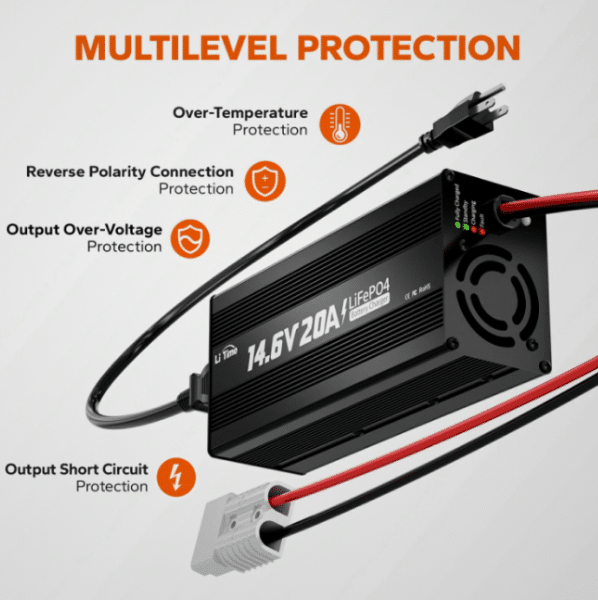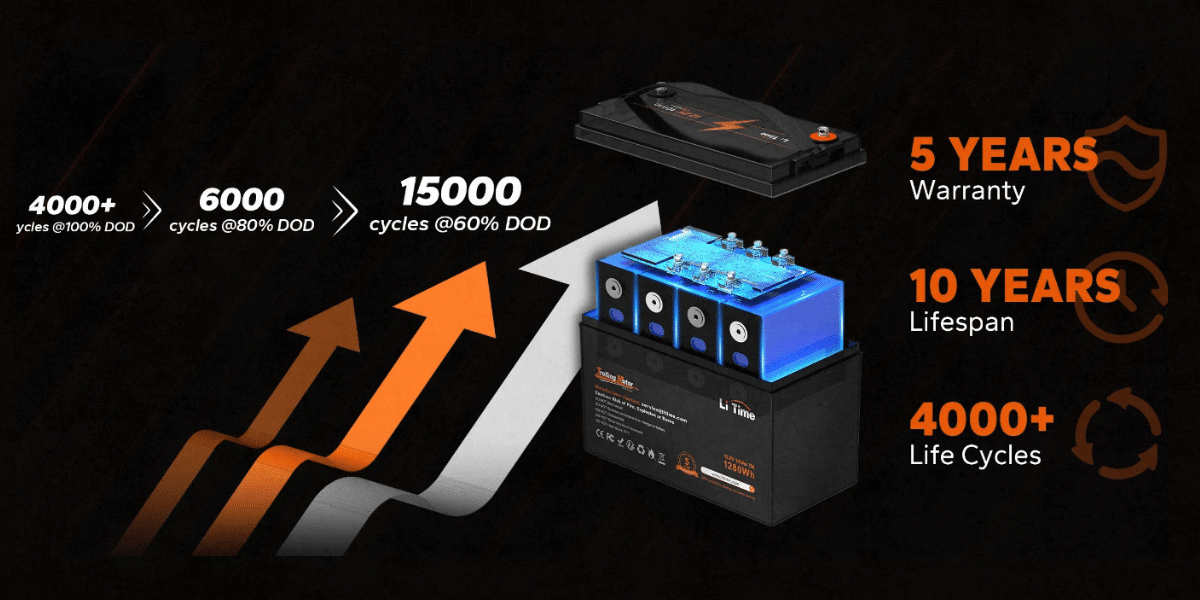Marine lithium batteries are prized for their safety and efficiency, offering extended usage times and stable power delivery. However, to maximize their performance and longevity, it’s essential to avoid certain charging pitfalls. This guide outlines common mistakes made during the charging process and how to use your marine lithium battery charger correctly.
Avoid Using Incompatible Chargers
One of the most frequent mistakes made by new lithium battery owners is using a charger that’s not designed for lithium batteries. While lead-acid battery chargers might work in some situations, they pose serious risks.
Lead-acid chargers often have voltage and current settings incompatible with lithium batteries. They can overcharge the battery by pushing the voltage beyond safe limits or delivering too much current, causing the battery to overheat and potentially leading to dangerous conditions.
Therefore, it’s best not to use a lead-acid battery charger for lithium batteries unless it’s an emergency.
As of September 5, 2024, the U.S. Consumer Product Safety Commission (CPSC) has reported 47 fires or other thermal incidents involving just two models of lithium battery chargers. These accidents were all linked to using incompatible chargers.
When a charger with an excessively high voltage or an amp rating that doesn’t match the lithium battery’s specifications is used, it can cause internal short circuits or overheating, leading to overcharging and, in some cases, even a fire.
For this reason, it’s crucial to always use a lithium battery charger specifically designed for marine lithium batteries. These chargers are built to provide precise voltage and current control, effectively preventing overcharging. Additionally, they come equipped with multiple safety features to keep your lithium battery safe and stable throughout the charging process.

However, inadequate heat dissipation in poorly ventilated or enclosed spaces can cause the battery temperature to rise quickly, increasing the risk of overheating.
Avoid charging outdoors in rainy or overly humid conditions to prevent such hazards. If necessary, take extra waterproof and moisture-proof precautions. Always ensure that the area around the battery and charger has ample space for proper airflow and heat dissipation, which helps prevent damage from overheating.
In summary, always charge your batteries in a dry, well-ventilated environment with appropriate temperatures to minimize safety risks and keep the charger and battery away from flammable materials. Proper heat dissipation is crucial for safe charging.
Carefully managing your charging environment boosts charging efficiency and greatly extends the battery’s lifespan, ensuring safety and reliability for your equipment and providing peace of mind.
Avoid Charging Lithium Batteries in High Heat or Humid Conditions
Lithium batteries are more robust and can handle tougher conditions than traditional lead-acid batteries. However, they still need a proper charging environment to maintain their performance and longevity.
To get the most out of your lithium batteries, it’s essential to monitor and optimize your charging environment regularly.
Most lithium batteries and their chargers are designed to operate within a safe temperature range—from just above freezing (32°F or 0°C) up to 150°F (around 65°C). However, for best results and to ensure your battery’s safety and longevity, it’s advisable to always charge them in an environment with moderate temperatures and humidity levels.
While lithium batteries can tolerate higher temperatures, long-term exposure to extreme heat or humidity can damage their internal components and lead to dangerous thermal runaway.
For example, in hot summer conditions, some boat owners might leave their batteries and chargers exposed on the deck, connected to shore power, and forget to move them to a shaded area. Prolonged exposure to direct sunlight can cause the battery and charger to overheat.
In these situations, overheating damages the charger and battery, which can result in internal component failure and, in severe cases, a fire.
To prevent this, always keep your charger and battery in a cool, shaded, and well-ventilated area when charging in hot weather to avoid overheating and ensure safe charging.
Additionally, Avoid Charging in Humid, Enclosed, or Poorly Ventilated Spaces. Charging in a humid or poorly ventilated environment can lead to serious safety issues.
In humid conditions, moisture can seep into the charger and battery, potentially causing short circuits, damage, or even explosions.
However, inadequate heat dissipation in poorly ventilated or enclosed spaces can cause the battery temperature to rise quickly, increasing the risk of overheating.
Avoid charging outdoors in rainy or overly humid conditions to prevent such hazards. If necessary, take extra waterproof and moisture-proof precautions. Always ensure that the area around the battery and charger has ample space for proper airflow and heat dissipation, which helps prevent damage from overheating.
In summary, always charge your batteries in a dry, well-ventilated environment with appropriate temperatures to minimize safety risks and keep the charger and battery away from flammable materials. Proper heat dissipation is crucial for safe charging.
Carefully managing your charging environment boosts charging efficiency and greatly extends the battery’s lifespan, ensuring safety and reliability for your equipment and providing peace of mind.
Avoid Charging After the Battery is Fully Discharged
The lifespan of a lithium battery is typically measured by its number of “charge-discharge cycles.” Depending on the battery’s chemical composition and manufacturing quality, most lithium batteries can last anywhere from 500 to 2,000 cycles. High-quality batteries, like LiTime LiFePO4 lithium batteries, use EV-Grade A cells, allowing them to achieve over 4,000 cycles.
But what exactly is a “charge-discharge cycle”? Simply put, each time your battery is fully drained from 0% to 100% and recharged back to 100%, it counts as one complete cycle.
If you often recharge your battery when only a small portion—say, 10%—20% of its capacity has been used (e.g., charging from 80% to 100%), these partial charges may add up. Eventually, the Battery Management System (BMS) will register several partial charges as one full cycle.
This means that even though you haven’t used the battery’s full capacity, the BMS will still count it as a complete cycle, shortening its lifespan.
Additionally, the BMS calculates the battery’s capacity based on its depth of discharge and charging patterns. Regularly recharging the battery when it’s not fully discharged can cause the BMS to “misinterpret” its true capacity, leading to inaccurate power level readings.
For instance, your device might show that there’s still 20% battery remaining, but in practice, the battery could run out much sooner.
Although lithium batteries don’t suffer from the traditional “memory effect” like older battery technologies, frequently charging at high battery levels can still result in a shorter lifespan and inaccurate power readings. To avoid this, keeping your lithium battery’s charge level between 30% and 80% before recharging is best. This practice minimizes unnecessary wear on the battery and helps extend its lifespan.
Avoid Continuing to Charge a Swollen Lithium Battery
While lithium batteries are generally stable and safe when used within the recommended charging and discharging limits, there are still cases of battery swelling due to misuse, age, or poor manufacturing practices.
Continuing to charge a swollen battery is like blowing air into an overinflated balloon—it’s only a matter of time before it bursts. Not only does this damage your device, but it also puts your safety at serious risk.
To avoid such situations, CBS News advises buying lithium batteries from reputable manufacturers who follow strict safety standards and are easily reachable in case of issues.
Final Thoughts
To ensure the best performance and longevity of your marine lithium battery, be sure to avoid the charging mistakes we’ve outlined and follow these key recommendations:
- Use a dedicated lithium battery charger: To avoid compatibility issues, always use a charger specifically designed for lithium batteries.
- Charge in a suitable environment: Ensure the battery is charged in a place with optimal temperature and conditions.
- Recharge only after a full discharge: To maximize its lifespan, recharge your lithium battery only after it has been fully discharged.
- Monitor battery health regularly: Check the condition of your lithium batteries frequently and ensure that you are using batteries that are in good health and meet safety standards.
Published by: Josh Tatunay

















